中国文化双语
- 格式:ppt
- 大小:7.88 MB
- 文档页数:44
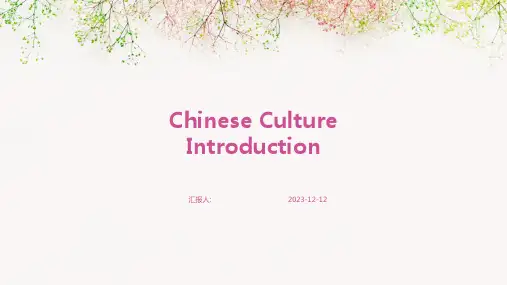

中国传统文化春节习俗中英双语介绍年的来历关于过年还有个传说,中国的新年跟打怪有关。
“年”其实是神话中的一种怪兽,会在新年的第一天来吃小孩子、牲口和粮食。
为了保护大家不受伤害,村民们将食物放在门口供“年”享用。
因为“年”惧怕红色和炮竹,过年大家便会挂红灯笼,放鞭炮。
Legend holds that the Chinese New Year began with a battle against a mythicalbeast called the Nian, who would come on the first day of the new year to eatchildren, livestock, and crops. In order to protect themselves from the Nian, villages put food in front of their doors believing that the creature would eat that and leave everything else alone. It was believed that the Nian was afraid of the colour red and firecrackers, so people would hang red lanterns outside and set off firecrackers.Little New Year, which falls the 23rd day of the 12th month in the Lunar calendar, is also known as the Festival of the Kitchen God, the deity who oversees the moral character of each household.小年农历腊月二十三日是小年,也是祭灶节。
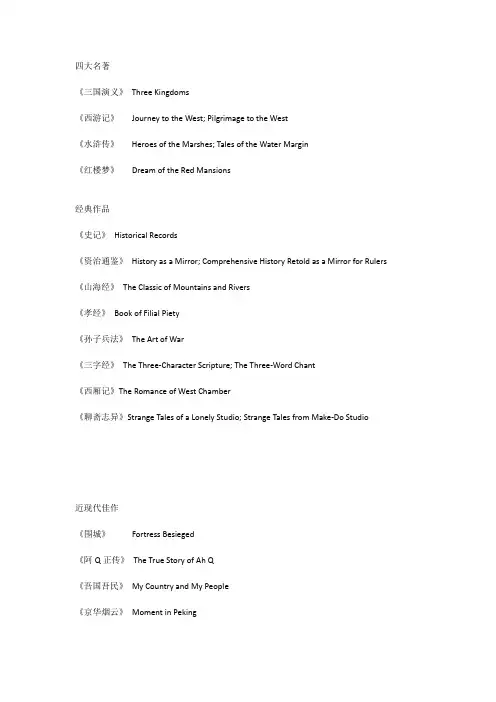
四大名著《三国演义》Three Kingdoms《西游记》Journey to the West; Pilgrimage to the West《水浒传》Heroes of the Marshes; Tales of the Water Margin《红楼梦》Dream of the Red Mansions经典作品《史记》Historical Records《资治通鉴》History as a Mirror; Comprehensive History Retold as a Mirror for Rulers 《山海经》The Classic of Mountains and Rivers《孝经》Book of Filial Piety《孙子兵法》The Art of War《三字经》The Three-Character Scripture; The Three-Word Chant《西厢记》The Romance of West Chamber《聊斋志异》Strange Tales of a Lonely Studio; Strange Tales from Make-Do Studio近现代佳作《围城》Fortress Besieged《阿Q正传》The True Story of Ah Q《吾国吾民》My Country and My People《京华烟云》Moment in Peking《骆驼祥子》Rickshaw《茶馆》Teahouse《边城》The Border Town《倾城之恋》Love in a Fallen City《十八春》Eighteen Springs四书五经四书The Four Books《大学》The Great Learning《中庸》The Doctrine of the Mean《论语》The Analects of Confucius《孟子》The Mencius/The Works of Mencius五经The Five Classics《春秋》The Spring and Autumn Annals《诗经》The Book of Songs; The Book of Odes《易经》(《周易》) I Ching; The Book of Changes 《礼记》The Book of Rites《尚书》(《书经》) The Book of History传统节日十二生肖The twelve Chinese zodiac signs本命年one's year of birth considered in relation to the 12 Terrestrial Branches 传统节日traditional holidays春节The Spring Festival元宵节The Lantern Festival清明节The Pure Brightness Festival / The Tomb-sweeping Day端午节The Dragon Boat Festival中秋节The Moon Festival / The Mid-Autumn Day重阳节The Double Ninth Day / The Aged Day文化遗产重要文化遗产major cultural heritage优秀民间艺术outstanding folk arts文物cultural relics中国画traditional Chinese painting书法calligraphy水墨画Chinese brush painting; ink and wash painting工笔traditional Chinese realistic painting中国结Chinese knot旗袍Cheongsam中山装Chinese tunic suit唐装traditional Chinese garments (clothing); Tang suit艺术词汇文人men of letters雅士refined scholars表演艺术performing art现代流行艺术popular art; pop art纯艺术high art高雅艺术refined art电影艺术cinematographic art才子佳人gifted scholars and beautiful ladies天干地支阳历solar calendar公历Gregorian calendar阴历lunar calendar天干heavenly stem地支earthly branch闰年leap year二十四节气The twenty-four solar terms寓言fable传说legend神话mythology赋诗inscribe a poem对对联matching an antithetical couplet中国瑰宝习武健身practice martial art for fitness气功qigong; deep breathing exercises工艺, 手艺workmanship; craftsmanship卷轴scroll蜡染batik泥人clay figure漆画lacquer painting唐三彩Trio-colored glazed pottery of the Tang Dynasty景泰蓝cloisonne文房四宝The four stationery treasures of the Chinese study——a writing brush, anink stick, an ink stone and paper.图片戏剧文化皮影戏shadow play; leather-silhouette show说书story-telling叠罗汉make a human pyramid折子戏opera highlights踩高跷stilt walk哑剧pantomime; mime哑剧演员pantomimist戏剧小品skit马戏circus show单口相声monologue comic talk; stand up comedy特技表演stunt相声witty dialogue comedy; comic cross talk杂技acrobatics京韵大鼓the traditional story-telling in Beijing dialect with drum accompaniment 秦腔Shaanxi opera图片国粹术语生(男性正面角色) male (The positive male role)旦(女性正面角色) female (The positive female role)净(性格鲜明的男性配角) a supporting male role with striking character丑(幽默滑稽或反面角色) a clown or a negative role花脸painted role歌舞喜剧musical滑稽场面,搞笑小噱头shtick京剧人物脸谱Peking Opera Mask汉语言汉字Chinese character单音节single syllable汉语四声调The four tones of Chinese characters 阳平level tone阴平rising tone上声falling-rising tone去声falling tone五言绝句five-character quatrain七言律诗seven-character octave八股文eight-part essay; stereotyped writing中国意念词八卦trigram阴、阳yin, yang江湖(世界) the jianghu World (the traits’world) You can't control everything in a traits' world.人在江湖,身不由己。
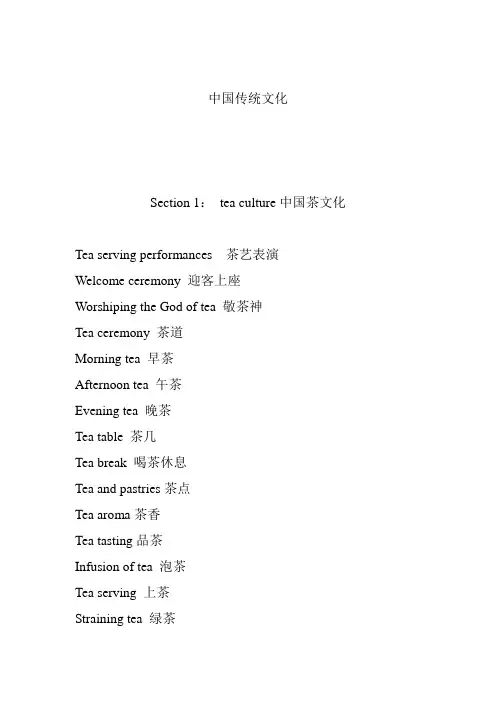
中国传统文化Section 1:tea culture中国茶文化Tea serving performances 茶艺表演Welcome ceremony 迎客上座W orshiping the God of tea 敬茶神Tea ceremony 茶道Morning tea 早茶Afternoon tea 午茶Evening tea 晚茶Tea table 茶几Tea break 喝茶休息Tea and pastries茶点Tea aroma茶香Tea tasting品茶Infusion of tea 泡茶Tea serving 上茶Straining tea 绿茶Sipping tea 呷茶First infusion of tea 头道茶Tea set 茶具Tea tray 茶盘Tea saucer茶碟Ceramic tea pot 紫砂壶Tea container 茶缸Tea caddy 茶叶罐Coaster 茶叶垫Tea strainer 滤茶器Tea spoon 茶匙Section 2:Chinese traditional festival中国传统节日Folkway 社会习俗Firecracker 鞭炮Red couplets 红对联Latern displays 灯盏Dumplings made of sweat rice 汤圆Eight treasure made of sweat rice 八宝饭Sweeping the grave 扫墓Lunar January 正月A portable light 灯笼Lion dance 舞狮Riddle written on latterns 灯谜Give new year’s greatings and visits 拜年Offer sacrifice to ancestors 祭祖Bid farewell to the old year 辞旧岁Family reunion dinner 团圆饭Dinner on New Year’s Eve 午夜饭W orship the moon god 祭月神Bless 祝福Demon 恶魔Lunar calendar农历Section 3 :Chinese ways of preserving health强身健体Barehanded boxing 徒手长拳The wielding of weapons 器械Kicking 踢Hitting 打Throwing 摔Controlling 拿Punching 击Thrusting 刺Fisting 拳打Twisting 扭身Horse stance 马步Bow stance 弓步Self defence 自我防卫External and internal work 内功和外功Self adjustment自我调整Self treatment自我治疗Palm pushing 推掌Requiredt toutine 规定的套路Sword play 剑术Spear play 枪术Reliving rigidity of muscle and joints活动筋骨Promoting the channel 舒经活络Regulating the flow of qi and blood 疏通气血Section 4:Chinese legacies 中国文化遗产Longmen grottoes 河南洛阳龙门石窟Imperial Palace of the Ming and Qing Dynasties 明清皇陵The Mogao carves 敦煌莫高窟Mausoleum of the First Qin Emperor 秦始皇陵Terracotta Warriors and Horses 兵马俑Beijing Forbidden City 北京紫禁城The temple of heaven in beijing 北京天坛Zhoukoudian site of peking man 周口店北京人遗址Dujiang weirs and qingchengshan mountain in sichuan province 四川都江堰和青城山Jiuzhaigou senic spot in sichuan province 四川九寨沟风景名胜区Wulingyuan tourist site in hunan 湖南武陵源风景名胜区Chengde summer resort and temples 承德避暑山庄Potala palace 西藏布达拉宫。

中国文化(中英文对照)中国文化(中英文对照)1. 元宵节:Lantern Festival2. 刺绣:embroidery3. 重阳节:Double-Ninth Festival4. 清明节:Tomb sweeping day5. 剪纸:Paper Cutting6. 书法:Calligraphy7. 对联:(Spring Festival) Couplets8. 象形文字:Pictograms/Pictographic Characters9. 人才流动:Brain Drain/Brain Flow10. 四合院:Siheyuan/Quadrangle11. 战国:Warring States12. 风水:Fengshui/Geomantic Omen13. 铁饭碗:Iron Bowl14. 函授部:The Correspondence Department15. 集体舞:Group Dance16. 黄土高原:Loess Plateau17. 红白喜事:Weddings and Funerals18. 中秋节:Mid-Autumn Day19. 结婚证:Marriage Certificate20. 儒家文化:Confucian Culture21. 附属学校:Affiliated school22. 古装片:Costume Drama23. 武打片:Chinese Swordplay Movie24. 元宵:Tangyuan/Sweet Rice Dumpling (Soup)25. 一国两制:One Country, Two Systems26. 火锅:Hot Pot27. 四人帮:Gang of Four28. 《诗经》:The Book of Songs29. 素质教育:Essential-qualities-oriented Education30. 《史记》:Historical Records/Records of the Grand Historian31. 大跃进:Great Leap Forward (Movement)32. 《西游记》:The Journey to the West33. 除夕:Chinese New Year’s Eve/Eve of the Spring Festival34. 针灸:Acupuncture35. 唐三彩:Tri-color Pottery of the T ang Dynasty/ The Tang Tri-colored pottery36. 中国特色的社会主义:Chinese-charactered Socialist/Socialist with Chinese characteristics37. 偏旁:radical38. 孟子:Mencius39. 亭/阁:Pavilion/ Attic40. 大中型国有企业:Large and Medium-sized State-owned Enterprises41. 火药:gunpowder42. 农历:Lunar Calendar43. 印/玺:Seal/Stamp44. 物质精神文明建设:The Construction of Material Civilization and Spiritual Civilization45. 京剧:Beijing Opera/Peking Opera46. 秦腔:Crying of Qin People/Qin Opera47. 太极拳:Tai Chi48. 独生子女证:The Certificate of One-child49. 天坛:Altar of Heaven in Beijing50. 小吃摊:Snack Bar/Snack Stand51. 红双喜:Double Happiness52. 政治辅导员:Political Counselor/School Counselor53. 春卷:Spring Roll(s)54. 莲藕:Lotus Root55. 追星族:Star Struck56. 故宫博物院:The Palace Museum57. 相声:Cross-talk/Comic Dialogue58. 下岗:Lay off/Laid off59. 北京烤鸭:Beijing Roast Duck60. 高等自学考试:Self-taught Examination of Higher Education61. 烟花爆竹:fireworks and firecracker62. 敦煌莫高窟:Mogao Caves63. 电视小品:TV Sketch/TV Skit64. 香港澳门同胞:Compatriots from Hong Kong and Macao65. 文化大革命:Cultural Revolution66. 长江中下游地区:The Mid-low Reaches of Yangtze River67. 门当户对:Perfect Match/Exact Match68. 《水浒》:Water Margin/Outlaws of the Marsh69. 中外合资企业:Joint Ventures70. 文房四宝(笔墨纸砚):"The Four Treasure of the Study" "Brush, Inkstick, Paper, and Inkstone"71. 兵马俑:cotta Warriors/ Terracotta Army72. 旗袍:cheongsam。
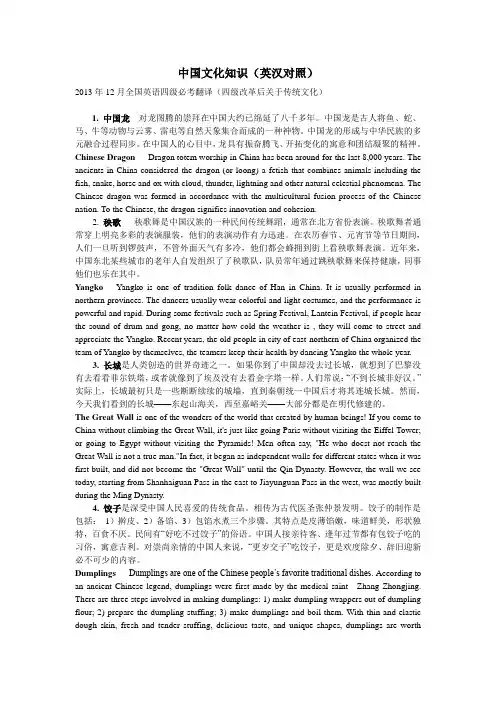
中国文化知识(英汉对照)2013年12月全国英语四级必考翻译(四级改革后关于传统文化)1. 中国龙对龙图腾的崇拜在中国大约已绵延了八千多年。
中国龙是古人将鱼、蛇、马、牛等动物与云雾、雷电等自然天象集合而成的一种神物。
中国龙的形成与中华民族的多元融合过程同步。
在中国人的心目中,龙具有振奋腾飞、开拓变化的寓意和团结凝聚的精神。
Chinese Dragon Dragon totem worship in China has been around for the last 8,000 years. The ancients in China considered the dragon (or loong) a fetish that combines animals including the fish, snake, horse and ox with cloud, thunder, lightning and other natural celestial phenomena. The Chinese dragon was formed in accordance with the multicultural fusion process of the Chinese nation. To the Chinese, the dragon signifies innovation and cohesion.2. 秧歌秧歌舞是中国汉族的一种民间传统舞蹈,通常在北方省份表演。
秧歌舞者通常穿上明亮多彩的表演服装,他们的表演动作有力迅速。
在农历春节、元宵节等节日期间,人们一旦听到锣鼓声,不管外面天气有多冷,他们都会蜂拥到街上看秧歌舞表演。
近年来,中国东北某些城市的老年人自发组织了了秧歌队,队员常年通过跳秧歌舞来保持健康,同事他们也乐在其中。
Yangko Yangko is one of tradition folk dance of Han in China. It is usually performed in northern provinces. The dancers usually wear colorful and light costumes, and the performance is powerful and rapid. During some festivals such as Spring Festival, Lantein Festival, if people hear the sound of drum and gong, no matter how cold the weather is , they will come to street and appreciate the Yangko. Recent years, the old people in city of east-northern of China organized the team of Yangko by themselves, the teamers keep their health by dancing Yangko the whole year.3. 长城是人类创造的世界奇迹之一。
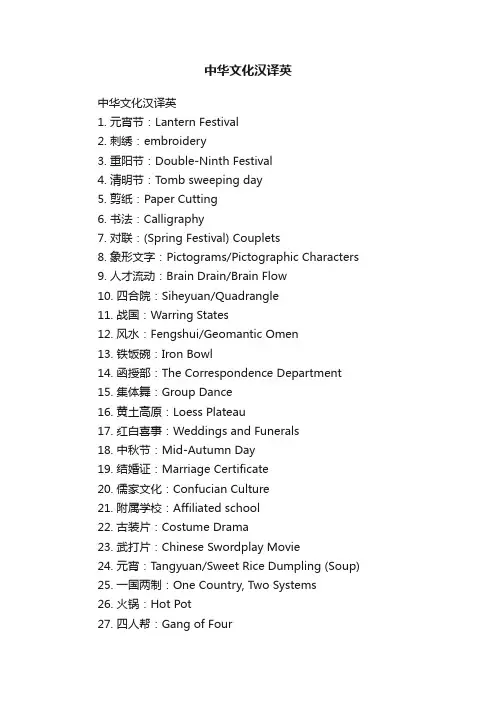
中华文化汉译英中华文化汉译英1. 元宵节:Lantern Festival2. 刺绣:embroidery3. 重阳节:Double-Ninth Festival4. 清明节:Tomb sweeping day5. 剪纸:Paper Cutting6. 书法:Calligraphy7. 对联:(Spring Festival) Couplets8. 象形文字:Pictograms/Pictographic Characters9. 人才流动:Brain Drain/Brain Flow10. 四合院:Siheyuan/Quadrangle11. 战国:Warring States12. 风水:Fengshui/Geomantic Omen13. 铁饭碗:Iron Bowl14. 函授部:The Correspondence Department15. 集体舞:Group Dance16. 黄土高原:Loess Plateau17. 红白喜事:Weddings and Funerals18. 中秋节:Mid-Autumn Day19. 结婚证:Marriage Certificate20. 儒家文化:Confucian Culture21. 附属学校:Affiliated school22. 古装片:Costume Drama23. 武打片:Chinese Swordplay Movie24. 元宵:Tangyuan/Sweet Rice Dumpling (Soup)25. 一国两制:One Country, Two Systems26. 火锅:Hot Pot27. 四人帮:Gang of Four28. 《诗经》:The Book of Songs29. 素质教育:Essential-qualities-oriented Education30. 《史记》:Historical Records/Records of the Grand Historian31. 大跃进:Great Leap Forward (Movement)32. 《西游记》:The Journey to the West33. 除夕:Chinese New Year’s Eve/Eve of the Spring Festiva l34. 针灸:Acupuncture35. 唐三彩:Tri-color Pottery of the T ang Dynasty/ The TangTri-colored pottery36. 中国特色的社会主义:Chinese-charactered Socialist/Socialist with Chinese characteristics37. 偏旁:radical38. 孟子:Mencius39. 亭/阁:Pavilion/ Attic40. 大中型国有企业:Large and Medium-sized State-owned Enterprises41. 火药:gunpowder42. 农历:Lunar Calendar43. 印/玺:Seal/Stamp44. 物质精神文明建设:The Construction of Material Civilization and Spiritual Civilization45. 京剧:Beijing Opera/Peking Opera46. 秦腔:Crying of Qin People/Qin Opera47. 太极拳:Tai Chi48. 独生子女证:The Certificate of One-child49. 天坛:Altar of Heaven in Beijing50. 小吃摊:Snack Bar/Snack Stand51. 红双喜:Double Happiness52. 政治辅导员:Political Counselor/School Counselor53. 春卷:Spring Roll(s)54. 莲藕:Lotus Root55. 追星族:Star Struck56. 故宫博物院:The Palace Museum57. 相声:Cross-talk/Comic Dialogue58. 下岗:Lay off/Laid off59. 北京烤鸭:Beijing Roast Duck60. 高等自学考试:Self-taught Examination of Higher Education61. 烟花爆竹:fireworks and firecracker62. 敦煌莫高窟:Mogao Caves63. 电视小品:TV Sketch/TV Skit64. 香港澳门同胞:Compatriots from Hong Kong and Macao65. 文化大革命:Cultural Revolution66. 长江中下游地区:The Mid-low Reaches of Yangtze River67. 门当户对:Perfect Match/Exact Match68. 《水浒》:Water Margin/Outlaws of the Marsh69. 中外合资企业:Joint Ventures70. 文房四宝(笔墨纸砚):"The Four Treasure of the Study" "Brush, Inkstick, Paper, and Inkstone"71. 兵马俑:cotta Warriors/ Terracotta Army72. 旗袍:cheongsam。
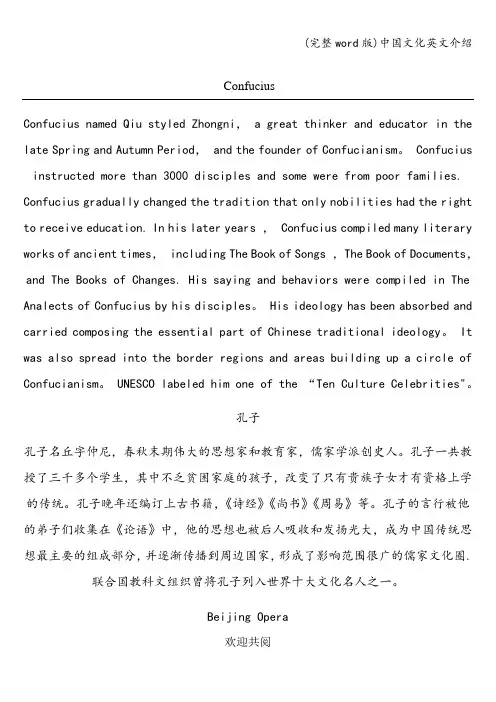
ConfuciusConfucius named Qiu styled Zhongni, a great thinker and educator in the late Spring and Autumn Period, and the founder of Confucianism。
Confucius instructed more than 3000 disciples and some were from poor families. Confucius gradually changed the tradition that only nobilities had the right to receive education. In his later years , Confucius compiled many literary works of ancient times, including The Book of Songs ,The Book of Documents,and The Books of Changes. His saying and behaviors were compiled in The Analects of Confucius by his disciples。
His ideology has been absorbed and carried composing the essential part of Chinese traditional ideology。
It was also spread into the border regions and areas building up a circle of Confucianism。
UNESC O labeled him one of the “Ten Culture Celebrities"。

中国文化中英文对照对龙图腾的崇拜在中国大约已绵延了八千多年。
中国龙是古人将鱼,蛇,马,牛等动物与云雾,雷电等自然天象集合而成的一种神物。
中国龙的形成与中华民族的多元融合过程同步。
在中国人的心目中,龙具有振奋腾飞,开拓变化的寓意和团结凝聚的精神。
Chinese DragonDragon totem worship in China has been around for the last8,000years. The ancients in China considered the dragon (or Loong)a fetishthatcombines animals includingthe fish,snake, horseand ox with cloud, thunder, lightning and other naturalcelestial phenomena. The Chinese dragon was formed inaccordance with the multiculturalfusionprocess of the Chinesenation. To the Chinese, the dragon signifies innovation andcohesion.饺子饺子是深受中国人民喜爱的传统特色食品。
相传为古代医圣张仲景发明。
饺子的制作是包括:1)擀皮、2)备馅、3)包馅水煮三个步骤。
其特点是皮薄馅嫩,味道鲜美,形状独特,百食不厌。
民间有“ 好吃不过饺子" 的俗语。
中国人接亲待友。
逢年过节都有包饺子吃的习俗,寓意吉利。
对崇尚亲情的中国人来说," 更岁交子" 吃饺子,更是欢度页脚内容除夕、辞旧迎新必不可少的内容。
DumplingsDumplings are one of the Chinese people'sfavoritetraditionaldishes.According to an ancientChinese legend,dumplings werefirst made by the medical saint-Zhang Zhongjing. There arethree steps involved in making dumplings: 1) make dumplingwrappers out of dumpling flour; 2) prepare the dumplingstuffing;3) makedumplings and boilthem. With thinand elasticdough skin, freshen and tender stuffing, delicious taste, and unique shapes, dumplings are worth eating hundreds of times.There's an old saying that claims, "Nothing could be moredeliciousthan dumplings."During the Spring Festivaland otherholidaysor when treatingrelativesand friends,Chinese peoplelike to follow the auspicious custom of eating dumplings. ToChinese people who show high reverence for family love, having dumplings at the moment the old year is replaced by the new is an essential part of bidding farewell to the old and ushering in the New Year.针灸针灸是中医学的重要组成部分。
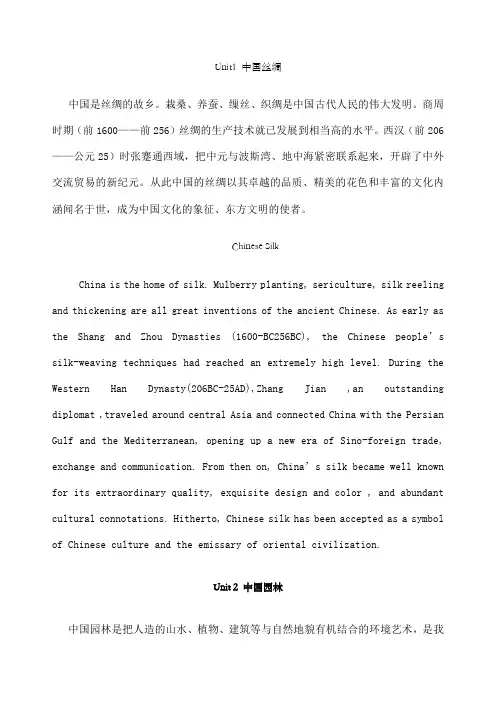
Unit1 中国丝绸中国是丝绸的故乡。
栽桑、养蚕、缫丝、织绸是中国古代人民的伟大发明。
商周时期(前1600——前256)丝绸的生产技术就已发展到相当高的水平。
西汉(前206——公元25)时张蹇通西域,把中元与波斯湾、地中海紧密联系起来,开辟了中外交流贸易的新纪元。
从此中国的丝绸以其卓越的品质、精美的花色和丰富的文化内涵闻名于世,成为中国文化的象征、东方文明的使者。
Chinese SilkChina is the home of silk. Mulberry planting, sericulture, silk reeling and thickening are all great inventions of the ancient Chinese. As early as the Shang and Zhou Dynasties (1600-BC256BC), the Chinese people’s silk-weaving techniques had reached an extremely high level. During the Western Han Dynasty(206BC-25AD),Zhang Jian ,an outstanding diplomat ,traveled around central Asia and connected China with the Persian Gulf and the Mediterranean, opening up a new era of Sino-foreign trade, exchange and communication. From then on, China’s silk became well known for its extraordinary quality, exquisite design and color , and abundant cultural connotations. Hitherto, Chinese silk has been accepted as a symbol of Chinese culture and the emissary of oriental civilization.Unit 2 中国园林中国园林是把人造的山水、植物、建筑等与自然地貌有机结合的环境艺术,是我国古代建筑艺术的珍宝。
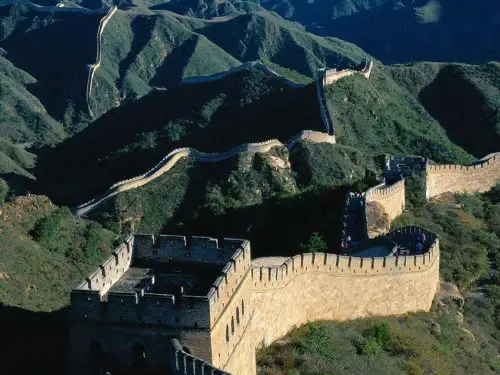
八拜之交:原表示世代有交情的两家弟子谒见对方长辈时的礼节,旧时也称异姓结拜的兄弟姐妹。
●friendship between sworn brothers or sisters●friendship between very close friends whounderstand each other and remend each otherat the sacrifice of their own interests莫逆之交:bosom friends总角之交:friendship between people who are friends since childhood一般作宾语,指儿时的朋友。
总角:古代未成年的人把头发扎成髻。
借指童年时期,幼年。
总角是八九岁至十三四岁的少年,古代儿童将头发分作左右两半,在头顶各扎成一个结,形如两个羊角,故称“总角〞。
贫贱之交:friendship between people who are poverty-stricken and from humble circumstances杵臼之交:friendship between people who do not care about the financial condition and social status of each other 杵:舂米的木棒;臼:石臼。
比喻交朋友不计较贫富和身分。
君子之交:friendship between gentlemen小人之交:friendship between villains狐朋狗友:people who often gather together doing something meaningless and even illegal棋友/牌友/球友:people who often meet to play chess, poker, ball. etc.战友:people who get to know each other while serving in the same army unit普通老百姓交的朋友谓“布衣之交〞;有钱人与没钱人交朋友谓“车笠之交〞;在逆境中结交的朋友称“患难之交〞;吃喝玩乐结交的朋友称“酒肉之交〞;年岁差异大,行辈不同而交情深厚的朋友称“忘年之交〞;幼年相交的朋友称“竹马之交〞;交情深厚的朋友谓“肺腑之交〞;亲密无间的朋友谓“胶漆之交〞;生死与共的朋友谓“生死之交〞;情投意合的朋友称“莫逆之交〞;哪怕砍头也不改变友谊的朋友称“刎颈之交〞;无意中相遇而结成的朋友称“邂逅之交〞;在道义上互相支持的朋友称“君子之交〞;只见过一次面,交情不深的朋友称“一面之交〞;仅点头打招呼,感情不深的朋友称“点头之交〞;平淡而浮泛交往的朋友称“泛泛之交〞;见过面但不熟悉的人称“半面之交〞;旧时结拜的兄弟姊妹称“八拜之交〞;交友不嫌贫贱称“杵逆之交〞;珍贵而有价值的交往称“金玉之交〞。
中国文化概况英汉对照版中国文化概况英汉对照版一:英文版:Chinese culture, with its rich heritage spanning thousands of years, is one of the oldest and most diverse cultures in the world. It is a blend of traditions, art, philosophy, and customs that have been shaped by the vast and diverse geography of China. From the ancient times of the Yellow Emperor and Confucius to the modern era, Chinese culture has continuously evolved while maintaining its unique identity.At the heart of Chinese culture lies its philosophical traditions, including Confucianism, Taoism, and Buddhism. These philosophies have profoundly influenced the moral and social values of the Chinese people. Confucianism, for instance, emphasizes the importance of family, respect for elders, and the pursuit of knowledge and wisdom.Chinese art, another vital aspect of its culture, encompasses a wide range of styles and mediums, including painting, calligraphy, sculpture, and ceramics. Chinese painting, known for its use of brush and ink, often depicts natural landscapes and scenes from history and mythology. Calligraphy, considered both an art and a way to cultivate one's character, is highly revered in Chinese culture.Cuisine is also a significant part of Chinese culture, characterized by its diversity and emphasis on harmony and balance. Chinese cuisine varies greatly from region to region, with each area having its own unique flavors and specialties. Traditional Chinese medicine, with its holistic approach to health, is another important aspect of the culture.Lastly, Chinese festivals and customs play a crucial role in cultural expression. The Spring Festival, or Chinese New Year, is the most important and widely celebrated festival in China. It is a time for family reunions, feasting, and the giving of red envelopes. Other notable festivals include the Dragon Boat Festival, Mid-Autumn Festival, and Lantern Festival, each with its own traditions and significance.汉语对照版:中国文化,拥有数千年的丰富遗产,是世界上最古老、最多样化的文化之一。
中国文化读本中英对照中文文化Introduction导言China, with a history spanning thousands of years, is one of the world's oldest and most influential civilizations. Its rich cultural heritage has made a profound impact on the world, with its contributions in art, philosophy, language, cuisine, and more. In this reading text, we will explore various aspects of Chinese culture and gain a deeper understanding of this ancient and vibrant civilization.中国,拥有数千年的历史,是世界上最古老和最有影响力的文明之一。
其丰富的文化遗产在世界上产生了深远的影响,在艺术、哲学、语言、美食等方面做出了贡献。
在这篇阅读文本中,我们将探索中国文化的各个方面,深入了解这个古老而充满活力的文明。
History历史China has a long and tumultuous history, with civilization dating back to ancient times. The country has gone through various dynasties, each leaving its mark on Chinese culture. From the Shang Dynasty to the Qing Dynasty, China has seen the rise and fall of powerful empires, each contributing to the growth and development of the Chinese civilization. The Great Wall, the Terracotta Army, and the Forbidden City are just a few examples of the country's rich historical heritage.中国有着悠久而曲折的历史,文明可以追溯到古代。
八拜之交:原表示世代有交情的两家弟子谒见对方长辈时的礼节,旧时也称异姓结拜的兄弟姐妹。
●friendship between sworn brothers or sisters●friendship between very close friends whounderstand each other and recommend eachother at the sacrifice of their own interests莫逆之交:bosom friends总角之交:friendship between people who are friends since childhood一般作宾语,指儿时的朋友。
总角:古代未成年的人把头发扎成髻。
借指童年时期,幼年。
总角是八九岁至十三四岁的少年,古代儿童将头发分作左右两半,在头顶各扎成一个结,形如两个羊角,故称“总角”。
贫贱之交:friendship between people who are poverty-stricken and from humble circumstances杵臼之交:friendship between people who do not care about the financial condition and social status of each other 杵:舂米的木棒;臼:石臼。
比喻交朋友不计较贫富和身分。
君子之交:friendship between gentlemen小人之交:friendship between villains狐朋狗友:people who often gather together doing something meaningless and even illegal棋友/牌友/球友:people who often meet to play chess, poker, ball. etc.战友:people who get to know each other while serving in the same army unit普通老百姓交的朋友谓“布衣之交”;有钱人与没钱人交朋友谓“车笠之交”;在逆境中结交的朋友称“患难之交”;吃喝玩乐结交的朋友称“酒肉之交”;年岁差别大,行辈不同而交情深厚的朋友称“忘年之交”;幼年相交的朋友称“竹马之交”;交情深厚的朋友谓“肺腑之交”;亲密无间的朋友谓“胶漆之交”;生死与共的朋友谓“生死之交”;情投意合的朋友称“莫逆之交”;哪怕砍头也不改变友谊的朋友称“刎颈之交”;无意中相遇而结成的朋友称“邂逅之交”;在道义上互相支持的朋友称“君子之交”;只见过一次面,交情不深的朋友称“一面之交”;仅点头打招呼,感情不深的朋友称“点头之交”;平淡而浮泛交往的朋友称“泛泛之交”;见过面但不熟悉的人称“半面之交”;旧时结拜的兄弟姊妹称“八拜之交”;交友不嫌贫贱称“杵逆之交”;宝贵而有价值的交往称“金玉之交”。
中国⽂化专题中英字幕版《你好,中国》(Hello,China)(完)《你好,中国》选取了100个代表中国传统⽂化精髓的汉语词汇,从不同侧⾯反映中国⽂化的博⼤精深,加深国外民众对中国和中华⽂化的了解。
视频来⾃⽹络,版权归原作者所有精品推荐往期回顾《你好,中国》| 01- Introduction to China《你好,中国》| 02-Ni Hao《你好,中国》| 03-Confucius《你好,中国》| 04-Sun Tzu《你好,中国》| 05-Lao Tzu《你好,中国》| 06-Sun《你好,中国》| 07-Moon《你好,中国》| 08-Chinese Lunar Calendar《你好,中国》| 09-Compass《你好,中国》| 10-Gunpowder《你好,中国》| 11-Paper《你好,中国》| 12-Printing《你好,中国》| 13-Peking Opera《你好,中国》| 14-Chinese painting《你好,中国》| 15-Chinese frescoes《你好,中国》| 16-Dance《你好,中国》| 17-Music《你好,中国》| 18-Chime Bells《你好,中国》| 19-Gu Qin《你好,中国》| 20-Calligraphy《你好,中国》| 21-Writing Brush《你好,中国》| 22-Journey to the West《你好,中国》| 23-Bamboo《你好,中国》| 24-Dragons《你好,中国》| 25-Phoenix《你好,中国》| 26-Kung Fu《你好,中国》| 27-Tai Chi Quan《你好,中国》| 28-Chinese sword《你好,中国》| 29-Traditional Chinese medicine《你好,中国》| 30-Acupuncture and Moxibustion《你好,中国》| 31-Spring Festival《你好,中国》| 32-Qingming Festival《你好,中国》| 33-Dragon Boat Festival《你好,中国》| 34-Qixi Festival《你好,中国》| 35-Mid-Autumn Festival《你好,中国》| 36-Water-Splashing Festival 《你好,中国》| 37-Animals Signs《你好,中国》| 38-Feng Shui《你好,中国》| 39-Lion Dance《你好,中国》| 40-Door Gods《你好,中国》| 41-Chinese wedding customs 《你好,中国》| 42-Matchmaker《你好,中国》| 43-Chrysanthemum《你好,中国》| 44-etiquette《你好,中国》| 45-Number one scholar《你好,中国》| 46-Beijing《你好,中国》| 47-Great Wall《你好,中国》| 48-Imperial Palace《你好,中国》| 49-Temple of Heaven《你好,中国》| 50-Xi'an《你好,中国》| 51-Terracotta Warriors《你好,中国》| 52-Yellow River《你好,中国》| 53-West Lake《你好,中国》| 54-Chinese Garden《你好,中国》| 55-Three Gorges《你好,中国》| 56-Dujiangyan Irrigation Dam 《你好,中国》| 57-Taishan Mountain《你好,中国》| 58-Danhuang《你好,中国》| 59-Shaolin Monastery《你好,中国》| 60-Dumplings《你好,中国》| 61-Beijing Roast Duck《你好,中国》| 62-Hotpot《你好,中国》| 63-Tanghulu《你好,中国》| 64-Tofu《你好,中国》| 65-Alcoholic Drinks《你好,中国》| 66-Noodles《你好,中国》| 67-Fish《你好,中国》| 68-Ethnic Groups《你好,中国》| 69-Chinese Names《你好,中国》| 70-Family《你好,中国》| 71-Courtyard《你好,中国》| 72-Alleyway《你好,中国》| 73-Tulou Building《你好,中国》| 74-Chinese tea《你好,中国》| 75-Chopsticks《你好,中国》| 76-Paper-Cutting《你好,中国》| 77-Chinese Silk《你好,中国》| 78-Porcelain Ware《你好,中国》| 79-Jade《你好,中国》| 80-Money《你好,中国》| 81-Lantern《你好,中国》| 82-Kite《你好,中国》| 83-Shadow Puppet《你好,中国》| 84-Wax Printing (Batik)《你好,中国》| 85-Brocade《你好,中国》| 86-Cheongsam《你好,中国》| 87-Tang Suit《你好,中国》| 88-Chinese Fan《你好,中国》| 89-Chinese Abacus《你好,中国》| 90-Panda《你好,中国》| 91-Magpie《你好,中国》| 92-Chinese Characters《你好,中国》| 93-Contradiction《你好,中国》| 94-Careless《你好,中国》| 95-Jealous《你好,中国》| 96-Bosom Buddy《你好,中国》| 97-Things (East and West)《你好,中国》| 98-Baby《你好,中国》| 99-Numerals《你好,中国》| 100-Ru Yi。